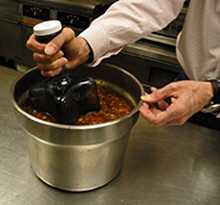Best Food Cooling Practices for Restaurants
This page shows the study purpose, method, results, conclusions, and recommendations in plain language for the EHS-Net project titled Food Cooling Practices Study.

The findings and recommendations from this project are also in fact sheet format [PDF - 234 KB].
Citations for more EHS-Net publications are available by Study Topic or by Citation.
Study Problem
Hot food needs to be cooled quickly to stop germ growth and foodborne illness outbreaks caused by germs. From 1998 to 2008, hot food cooled too slowly led to 504 outbreaks of foodborne illness in restaurants. If we learn more about how restaurants cool food, we can improve how they do it. And we can lower the number of foodborne illness outbreaks.
The U.S. Food and Drug Administration (FDA) Food Code includes advice on how to cool food safely and quickly. This advice includes cooling food
- to 41°F in 6 hours and
- in a way that allows food to cool quickly. Food can be cooled quickly
- in shallow pans and
- in a way that air can flow around and in the pans (ventilated).
The Food Code also recommends that food cooling time and temperature be monitored during cooling.
Study Purpose
The purpose of this study is to examine how cooling practices like pan depth, ventilation, and time and temperature monitoring are linked to how fast food cools.
Study Findings in Brief
Estimates showed that 35% of the foods we monitored while cooling would have taken longer than 6 hours to reach 41°F (the Food Code guideline).
Following the Food Code guidelines of storing foods at shallow depths, ventilating foods, and monitoring cooling food time or temperatures help foods cool faster.
Study Method
State or local environmental health specialists watched food cooling practices in 420 restaurants. The restaurants were in the 2009 EHS-Net sites and were chosen at random to participate in the study.
The specialists took notes on
- the depth of cooling food,
- whether cooling food was ventilated, and
- whether workers monitored the time or temperature of cooling food.
They also took temperatures of cooling food at the beginning and end of their restaurant visit. The average visit lasted 80 minutes. The food temperatures were used to estimate how long it would take to cool the food to 41°F.
Study Results
Sixty-five percent of cooling foods had an estimated cooling time that was as fast as or faster than the Food Code guideline (cooling to 41°F in 6 hours).
Thirty-five percent of cooling foods had an estimated cooling time that was slower than the Food Code guideline.
Fifteen percent of cooling foods had an estimated cooling time that was only slightly slower than the Food Code guideline.
Foods not being monitored by workers were more than twice as likely to cool slower than the Food Code guideline.
Food in pans at a food depth greater than 3 inches was twice as likely to cool slower than the Food Code guideline.
Unventilated cooling foods were almost twice as likely to cool slower than the Food Code guideline.
Study Conclusions
Many of the foods with cooling times slower than in the Food Code were cooling only slightly slower than the guidelines. Restaurants with only slightly slower cooling foods may need only to make small changes to their cooling practices to comply with the Food Code guideline.
Following the Food Code guidelines of storing foods in shallow pans, ventilating foods, and monitoring food time or temperatures led to faster food cooling times.
Monitoring was the most effective cooling practice.
EHS-Net Recommends
Restaurant management should consider storing foods in shallow pans, ventilating foods, and keeping track of cooling food time or temperatures. These practices help foods cool faster.
Food safety programs should consider focusing on the practices of storing food in shallow pans, ventilating foods, and keeping track of food time or temperature during their inspections.
- The lack of these practices can be markers of a slower cooling process.
- These practices can be assessed far more quickly than can the full cooling process.
Key Terms
- Environmental health specialists: public health workers who enforce health and safety standards related to food and other consumer products.
- Foodborne illness: an illness caused by germs in food.
- Foodborne illness outbreak: when two or more people have the same sickness after eating food from the same place.
- Ventilation: air flow around an object.
- Page last reviewed: February 10, 2015
- Page last updated: August 16, 2016
- Content source:


 ShareCompartir
ShareCompartir